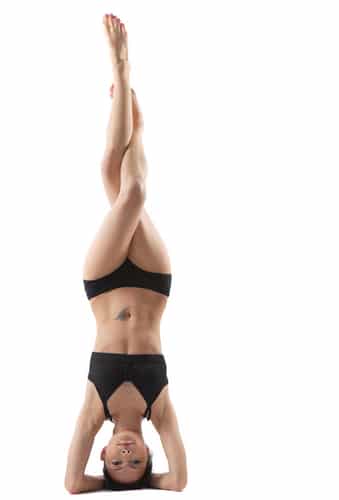
Hatha
Hatha yoga is a general term that encompasses most of the physical styles of yoga. Because yoga also includes meditation and breathing techniques, the term Hatha is used to refer to all physical forms of yoga. Classes that are advertised as hatha yoga, will generally be calm and gentle. Hatha yoga is ideal for beginners, as it teaches you all the basic asanas. You will learn how to move into poses gradually and to combine movement with the breath. Learning how to do asanas correctly is important to get the most out of yoga.
Vinyasa
Vinyasa has more than one meaning. Just like hatha, vinyasa is a general term used to describe more than one type of yoga. Vinyasa, meaning breath-synchronized movement, is a powerful style of yoga where you move or flow as it is often called, from one asana to the next. Vinyasa yoga usually starts with a series of sun salutations to warm up the body before moving on to more intense vinyasas. This is the second meaning of the term, a series of asanas performed in a flowing style, one after the other. Vinyasa yoga, sometimes called flow yoga, can be gentle to vigorous depending on which poses are included. In vinyasa yoga, you can pace yourself by staying in an asana for a while before moving on to the next. That makes it an ideal choice for both beginners and intermediate yogis and yoginis.
Ashtanga
Ashtanga, sometimes spelled ashtanga, is Sanskrit for eight limbs. The name refers to the eight stages that this yoga style incorporates. It is a fast and intense yoga style in which you perform a fixed series of poses, always in the same order. Ashtanga yoga is physically demanding because you are constantly moving from one pose to the next. In yoga terminology, this movement is called flow. Ashtanga yoga is the inspiration behind what is often called power yoga. This last yoga form is based on the flowing style of Ashtanga, but it doesn’t require keeping to a strict order of poses. Ashtanga yoga is more suitable if your skills are intermediate to advanced. The fast movement may prevent beginners from learning the correct posture of asanas.
Iyengar
This yoga style is based on the teachings of yogi Bellur Krishnamachar Sundararaja (B.K.S.) Iyengar. Iyengar yoga places great importance on body alignment. This is the exact way in which every part of your body is positioned when doing poses. To get the maximum benefit from every pose and to help prevent injury, Iyengar yoga prescribes the use of all kinds of aids, helping to hold the body in the right position. These could be blocks, blankets, or belts. In Iyengar yoga, you hold asanas for longer, and you don’t flow quickly from one pose to the next. This makes it suitable for beginners as well as intermediate or advanced students of yoga, who would like to study the exact anatomy of every asana.
Kundalini
Kundalini yoga combines controlled breathing with repetitive body movement to release blocked energy in the lower body and move it upwards through the seven chakras, or energy centers, along the spine. This yoga style goes beyond physical exercise and is said to heighten awareness through meditation, breathing, and chanting. Even though this is a more spiritual form of yoga, some of the repetitive body movements and the more difficult breathing exercises can be very challenging. This style of yoga is ideal if you want to build up mental resilience.
Bikram
Bikram yoga, also called hot yoga, was developed by yoga master Bikram Choudhury. This yoga style is practiced in a room with a temperature of 95 to 100 degrees Fahrenheit (35 to 38 degrees Celsius). The warm temperature helps tense muscles to release, making a deeper practice possible, You will also start to sweat, but don’t worry. Sweating is beneficial as it helps to cleanse your body from the inside. The Bikram method consists of a fixed series of 26 poses and two breathing exercises. Each exercise is performed twice in a 90-minute class. The high temperature makes practice more intense, so in this yoga method, they claim you burn more calories than in a regular yoga session.
A lot of people are initially drawn to yoga as a way to keep fit, but after practicing for some time they begin to feel the deeper benefits. Yogis and yoginis rave about yoga’s significant impact on their wellbeing and clarity of mind. Yoga, as you can see from the number of different styles available, is not one size fits all. So, try a few different classes if you can, before you commit to a complete course.
Related Articles By Cathe:
Can the Practice of Yoga Slow Brain Aging?
Yoga and Aerobic Exercise Are Synergistic for Heart Health
Does Yoga Improve Bone Health?
Can Yoga Be a Cardiovascular Workout?
Is a Yoga Workout Effective for Building Strength?
Does Yoga Help With Weight Loss?
4 Benefits of a Relaxing Yoga Workout if You Do High-Intensity Exercise

